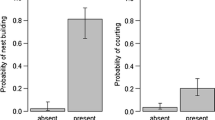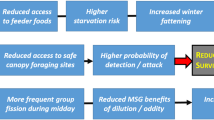Summary
The value of being dominant in winter flocks of willow tits may not only be a matter of personal survival for males, although their survival probability was highest among flock members. Winter flocks of willow tits contain male-female subunits, and the dominant pair may be viewed as an alliance based on mutual benefits. Dominant males provide their mates with protection in winter, and females return the help in reproductive success. Survival was directly related to rank only within sexes. Mates of dominant males survived significantly better than low-ranked males even though these females were subordinate to these males in direct interactions. Mates of dominant males were relatively spared from costs of low rank as they were subject to aggression less often than expected. Presumably dominant males prevented such attacks, as they excluded other flock members from high tree sections where their mates fed. Males should gain from improving the survival probability of their mates since it was not always possible to replace lost mates in spring populations having a male-biased sex ratio. Dominance in avian winter flocks may thus have more indirect effects than merely to improve the personal survival probability through resource priority. The benefits of being a dominant suggest that subordinate willow tits join groups because there is no space available for them to take up a territory as dominants.
Similar content being viewed by others
References
Axelrod R, Hamilton WD (1981) The evolution of cooperation. Science 221:1390–1396
Bradley JV (1968) Distribution-free statistical test. Prentice Hall, London
Bradley DW (1985) The effect of visibility bias on time budget estimates of niche breadth and overlap. Auk 102:493–499
Brown JL (1963) Aggressiveness, dominance, and social organization in the Steller Jay. Condor 65:460–484
Caraco T (1979) Time budgeting and group size: a test of theory. Ecology 60:618–627
Cederholm G, Ekman J (1976) A removal experiment on crested tit Parus cristatus and willow tit P. montanus in the breeding season. Ornis Scand 7:207–213
Dixon KL (1963) Some aspects of social organization in the Carolina chickadee. Proc XIII Int Ornithol Congr:240–258
Dixon KL (1965) Dominance-subordination relationship in the Mountain chickadee. Condor 67:291–299
Dunbar RIM (1988) Primate social systems. Studies in behavioural adaptations. Croom Helm, Bekenhem, U.K.
Ekman J (1979) Coherence, composition and territories of winter social groups of the Willow Tit Parus montanus and the Crested Tit P. cristatus. Ornis Scand 10:56–68
Ekman J (1984) Density-dependent seasonal mortality and population fluctuations of the temperate-zone Willow Tit (Parus montanus). J Anim Ecol 53:119–134
Ekman J (1986) Tree use and predator vulnerability of wintering passerines. Ornis Scand 17:261–267
Ekman J (1987) Exposure and time use in willow tit flocks: the cost of subordination. Anim Behav 35:445–452
Ekman J (1989a) Group size in dominance-structured populations. Ornis Scand 20:86–88
Ekman J (1989b) Subordination costs and group territoriality in wintering willow tits. Proc XIX Int Ornithol Congr:2373–2381
Ekman J, Askenmo C (1984) Social rank and habitat use in willow tit groups. Anim Behav 32:508–514
Ekman J, Cederholm G, Askenmo C (1981) Spacing and survival in winter groups of Willow Tits Parus montanus and Crested Tit P. cristatus — a removal study. J Anim Ecol 50:1–9
Fretwell S (1969) Dominance behaviour and winter habitat distribution in juncos (Junco hyemalis). Bird-banding 40:1–25
Glase J (1973) Ecology of social organization in the black-capped chickadee. Living Bird 12:235–267
Haftorn S (1982) Variation in body measurements of the Willow Tit Parus montanus, together with a method for sexing live birds and data on the degree of shrinkage in size after skinning. Fauna Norw Ser C 5:16–26
Hogstad O (1987a) Social rank in winter flocks of Willow Tits Parus montanus. Fauna Norw Ser C 129:1–9
Hogstad O (1987b) It is expensive to be dominant. Auk 104:333–336
Hogstad O (1988a) Rank-related resource access in winter flocks of Willow Tits Parus montanus. Ornis Scand 19:169–174
Hogstad O (1988b) Social rank and antipredator behaviour of Willow Tits Parus montanus in winter flocks. Ibis 130:45–56
Hogstad O (1989) Subordination in mixed-age bird flocks — a removal study. Ibis 131:128–134
Jansson C, Ekman J, Brömssen A von (1981) Winter mortality and food supply in tits Parus spp. Oikos 37:313–322
Kikkawa J (1968) Social hierarchy in winter flocks of the Greybreasted Silvereye Zosterops lateralis (Latham). Jpn J Ecol 18:235–246
Koivula K, Orell M (1988) Social rank and winter survival in the willow tit Parus montanus. Ornis Fenn 65:114–120
Laaksonen M, Lehikoinen E (1976) Age determination of Willow and Crested Tit Parus montanus and P. cristatus. Ornis Fenn 53:9–14
Lehman EL (1959) Testing statistical hypotheses. Wiley, New York
Lima SL (1986) Predation risk and unpredictable feeding conditions: determinants of body mass in birds. Ecology 67:377–385
Packer C, Pusey A (1982) Cooperation and competition within coalitions of male lions; kin selection or game theory? Nature 296:740–742
Røskaft E, Järvi T, Bakken M, Bech C, Reinertsen RE (1986) The relationship between social status and resting metabolic rate in great tits (Parus major) and pied flycatchers (Ficedula hypoleuca). Anim Behav 34:838–842
Rohwer S, Ewald PW (1981) The cost of dominance and advantage of subordination in a badge signaling system. Evolution 35:441–454
Sabine WS (1959) The winter society of the Oregon junco: intolerance, dominance and the pecking order. Condor 61:110–135
Smith SM (1984) Flock switching in chickadees; why be a winter floater? Am Nat 123:81–98
Author information
Authors and Affiliations
Rights and permissions
About this article
Cite this article
Ekman, J. Alliances in winter flocks of willow tits; effects of rank on survival and reproductive success in male-female associations. Behav Ecol Sociobiol 26, 239–245 (1990). https://doi.org/10.1007/BF00178317
Received:
Accepted:
Issue Date:
DOI: https://doi.org/10.1007/BF00178317




